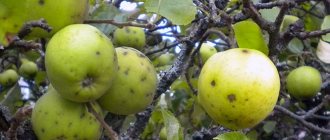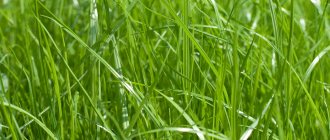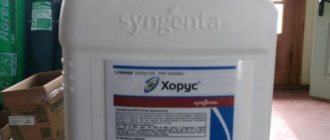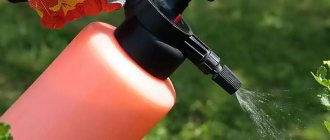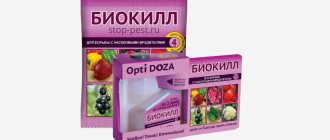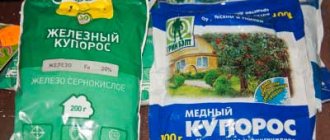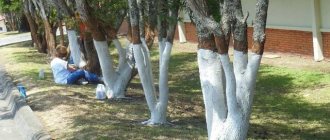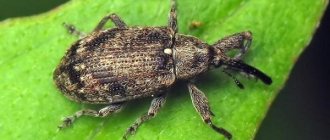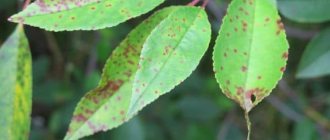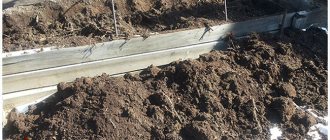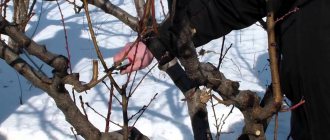Spraying trees in spring.
How to spray trees during the pink bud period, before and after flowering?
In spring, not only the garden awakens. Its pests and pathogens are also preparing to begin “work.” The fight against them should begin in the phases of swelling and blossoming of leaf buds: shake off weevils and apple blossom beetles onto the litter in the morning hours at a temperature not exceeding 10 degrees and destroy them, carry out blue spraying with Bordeaux mixture against an outbreak of scab.
You should put catching belts, hang jars or plastic bottles, cutting them in half, with fermented compote, kvass, diluted jam.
The next phase of the spring development of the garden is the pink bud, when the soft pink tips of the flower petals appear from the flower buds and the leaves increase in size. This is the time before flowering. If the trees were not sprayed with Bordeaux mixture during the bud bursting or green cone phase to prevent rust, scab and other diseases, then it will be necessary to do this at this time. The same is recommended for treating peach against leaf curl if such spraying is not carried out before the buds open.
Apricots, plums, and peaches will be helped to resist hole spot by spraying with a one percent suspension of colloidal sulfur or a one and a half percent suspension of freshly slaked lime. During the bud extension phase, larvae of pear psyllids, silkworms, sawflies, and leaf-eating caterpillars appear. It will be possible to use such approved insecticides as Bi-58, Decis and others against them, especially if the trees are not treated with one of these drugs during the swelling phase of leaf buds.
During flowering of trees, chemical spraying is not recommended. And after it, if in previous seasons the trees; suffered greatly from scab, rust, coccomycosis and other diseases, it will be possible to spray them again with one percent Bordeaux mixture. If they appear, treatment will help against the sawfly, codling moth, and leaf rollers; Zolon, Dursban and other approved drugs.
However, it should be remembered that when spraying trees, an individual approach is important not only to each crop, but also to each variety. There are diseases that affect only stone fruit trees, or only fruit trees. And each crop has its own pests. In addition, some varieties are resistant, say, to scab, while others are not so much, which means that the latter are more in need of protective measures.
Rules and recommendations
Autumn treatment of the garden and vegetable garden with iron and copper sulfate
Treatment of the garden in early spring with urea is carried out according to the following plan and with the corresponding recommendations:
It is necessary to prepare trees for nitrogen spraying
To do this, you need to dig up the ground under them, remove branches damaged after winter or withered and whiten the trunks. When preparing the solution and spraying, it is important to observe protective measures. Clothing should protect the skin, eyes and other parts of the body from contact with the chemical compound
A mask, goggles and gloves are mandatory attributes when treating a garden with urea. For convenience, a special sprayer is used, which can be purchased at garden supply stores. It will allow you to treat even hard-to-reach places and tree tops with the mixture. Even a large amount of urea will not harm plants. Therefore, you can not save money and try to process the garden to the maximum. If fertilizers were used to feed plants, the amount of urea is reduced by 1/3 or 2 times. It depends on the volume of organic matter.
There is another option, in which urea is not diluted in water, but poured dry under trees. In this case, the product must be diluted with water so that it is absorbed into the ground.
It is recommended to process plants in sunny and calm weather. It is advisable to carry out the procedure early in the morning or at sunset. In case of rain or snow, it will be necessary to repeat spraying on another day.
Timing for spraying fruit trees
Autumn spraying should be done just before the onset of winter, when all the leaves have already fallen. Earlier treatment can lead to negative consequences, such as leaf burns and untimely leaf fall.
Latest articles about gardening
This will not only not bring a positive result, but will also lead to a weakening of the garden, which has not had time to receive all the nutrients and properly prepare for winter.
You need to start spraying in November, when there is no longer any danger of damaging the leaves with chemicals. Before starting treatment, you need to remove lichens and old bark from old trees with a metal brush.
Preparing the garden for treatment with urea
Peonies are kings of the spring garden, planting and care in open ground
Before winter, insects look for cozy places to hide from frost. Such places are considered to be fallen leaves and tree bark. That is why garden spraying is carried out in late autumn. Such manipulations will protect trees from the invasion of scab, putrefactive diseases, and other misfortunes. As a result of garden treatment, the vegetative process is accelerated, the proliferation of pathogenic microorganisms stops or significantly slows down.
To obtain the desired result, you need to properly prepare the plants. The process is carried out in several stages, taking into account the age of the plantings:
- if the trees are more than six years old, get rid of old bark and lichen. To do this, use a special metal brush; such manipulations will help eliminate all secluded places for pathogens and parasites;
- Before the first frost, treat the trees, first remove fallen leaves, weeds and branches.
Many gardeners prefer to cultivate their garden in late autumn (from early October to the end of the month). Just before the cold weather, carrying out the procedure is most beneficial for plants. If the procedure is carried out in early autumn (September), it is detrimental to the plants. They will be left without vitamins and minerals, may get burns, and lose leaves early. The depressing condition of the garden will contribute to the attack of pests in the spring; it is good if the plant survives.
For sick plants, perform unscheduled manipulations. Also, after treatment with urea, many gardeners whiten trees. A combination of useful manipulations shows excellent results.
Important! It is highly undesirable to treat the garden before rain. Rain will simply destroy the fertilizer, nullify your work, and the plants will remain unprotected
Carry out manipulations on a sunny, windless day.
Autumn treatment of the garden with urea and iron sulfate. Properties of nitrogen fertilizer
Urea refers to concentrated nitrogen compounds, which should not be confused with nitrate, which is harmful to the garden crown. The composition is sold in the form of whitish granules without a pronounced odor. The crystals dissolve faster in water heated to +80°C, which makes it easier for the solution to be sprayed on the treated area. The hygroscopic composition should be stored in sealed boxes. Gardeners prefer spraying with urea in the fall not only for its 46% nitrogen concentration, but specifically for its intensive digestibility by garden crops that need to be saved from parasites.
When working with urea in the fall, remember:
- Ureas are organic fertilizers, but their composition is determined by mineral nitrogen-containing components;
- This is a fast-acting concentrate whose properties last for a long period;
- the fertilizer quickly erodes, therefore it requires irrigation directly of the soil, including greenhouse and greenhouse soil;
- the connection is effective in waterlogged areas;
- biologically active soil retains more nitrogen than alkaline or neutral soil environments;
- nitrogen-containing fertilizers are more effective and safe for the garden in the autumn, when the foliage does not burn if the concentration is disturbed;
- urea slows down the growing season, delaying flowering from spring frosts that are fatal to the ovary. This will have a fruitful effect on the preservation of early ripening varieties of plum, peach and apricot, and the fruit trees themselves preserve the developing buds;
- after spraying in the fall, garden pests are killed, and various diseases of garden crops are eliminated;
- after combining with earth, urea turns into ammonium carbonate;
- nitrogen-containing compounds do not accept compounds with chalk, lime and simple superphosphates;
- urea helps get rid of old stumps, causing them to quickly rot;
- Autumn treatment of the garden with nitrogen concentrate protects garden plants from early frosts.
Urea for soil fertilization and pest control
One of the most famous and effective means for fertilizing the soil among gardeners is urea (urea). Feeding apple trees with urea in the spring is an excellent and quick way to improve the soil and increase nutrients.
Urea is a mineral fertilizer with a high nitrogen content. Externally, urea resembles white or pale yellow crystals. Urea has no aroma; when it interacts with water, it will instantly dissolve.
Manufacturers usually package urea in the form of granules so that it does not cake and is distributed evenly over the soil. Due to the fact that urea contains a lot of nitrogen, it is quickly absorbed by the tree. Urea is a synthetic fertilizer that is made from ammonia and carbon dioxide. In this regard, the cost of urea is slightly higher than the price of other fertilizers.
It can be used to treat fruit trees (apple trees, pears) almost at any time of the year. In spring, it is used as protection against various diseases and pests. In summer (usually in mid-June) it is used as top dressing, in autumn - for the purpose of prevention. In winter, urea is not recommended.
Important! Urea is used not only as a solution that fertilizes the soil, but also as an effective remedy that can fight various types of pests
Spraying apple trees with urea in spring
This product is perfect for controlling insects such as:
- aphid;
- slowpoke;
- weevil;
- apple blossom beetle.
Treating apple trees in the spring against diseases and pests with urea is very popular among farmers. It is advisable to begin destroying pests during their wintering, when the air temperature rises above 6 degrees. The trunks of fruit trees are sprayed with a solution at the rate of 60 g. for 1 liter of water.
When pests penetrate under the bark of an apple tree, they can also be gotten rid of using a concentrated urea solution.
Fertilizing will also help protect apple trees from the following diseases:
- purple spot;
- burns
- scab.
It is necessary to prepare a solution in the following proportion: 500 g. urea per 10 liters of water. It is sprayed on fruit trees whose leaves are damaged by diseases. This procedure is carried out at the end of autumn, before the onset of frost.
How to spray the garden in the fall against diseases and pests: the best remedies
Compared to spring treatment, the choice of products for autumn garden spraying is not as wide, but in any case, you should familiarize yourself with the most effective products suitable for eradication treatment.
inkstone
It is perhaps the most popular means for autumn eradication of the garden.
Iron sulfate will greatly help in the prevention and protection against many fungal diseases and infections , such as scab , powdery mildew , various rots, including moniliosis (fruit rot) .
It (iron sulfate) will also help get rid of mosses and lichens (in theory, after treatment they will die and fall off the bark on their own).
Naturally, spraying will enrich the soil and plant with iron .
By the way! Read more about the use of iron sulfate in gardening in this article.
Some gardeners believe that iron sulfate also works against harmful insects that overwinter in the bark.
However! There is an opinion that it is useless to fight pests during eradication spraying in the fall, because... They themselves die, but all the eggs have long been laid, the larvae have pupated and hid.
And the presence of a solution of iron sulfate on the shoots of ornamental plants, which are covered for the winter, prevents them from propping up during thaws .
As for the consumption of the product, it directly depends on the condition of your plants this season - whether they were sick and how severe the infection was. Thus, the dosage (concentration) is as follows:
- if the plants were not sick or practically not sick - 200-300 grams per 10 liters of water;
- if trees and shrubs were sick - 400-500 grams per 10 liters of water.
By the way! There is an opinion that it is better to treat stone fruit crops (plums, apricots) with no more than a 3% solution, but pome crops (apple trees, pears) with a 5% solution.
Video: autumn treatment of the garden with iron sulfate - what is it for, how to do it correctly, what are the features of application
Urea (Urea)
Urea is another effective and very powerful tool for autumn garden treatment.
Although, as a rule, urea is used in nitrogen fertilizer, which is applied in the spring and early summer.
At a high concentration, this product (in these conditions, no nitrogen fertilizing) actually burns out all infections (in other words, it allows you to destroy the most persistent and difficult to eradicate sources of diseases ) , and also really fights many pests that have decided to overwinter on the branches (in the bark) and in the tree trunk circle (for example, with mites, scale insects and even glass beetles).
Thus, urea plays the role of both a fungicide and an insecticide.
However, urea is usually used in combination with iron sulfate .
What concentration of urea solution is needed to treat the garden?
The dose primarily depends on whether your plants were sick this year and how severe the infection was :
Important! Concentration does not depend on age.
- if the trees and shrubs were not sick (the garden was “clean”) - 300 grams per 10 liters of water;
- if you were sick - 500-700 grams per 10 liters of water.
Note! Indeed, urea (carbamide) is a nitrogen fertilizer , which in the autumn can provoke the growth of shoots, but due to the fact that the treatment is carried out shortly before the first frost, urea will not cause any effect other than “eradicating” (fungicidal and insecticidal).
Ideal combination: iron sulfate + urea
To increase the effectiveness of eradicative autumn treatment of the garden, it is very advisable to mix urea and iron sulfate , preparing a kind of tank mixture.
That is, for example, dissolve 300-500 grams of urea and 200-500 grams of iron sulfate in 10 liters of water.
By the way! Urea will certainly act against the larvae of harmful insects.
Video: autumn treatment of trees and shrubs with iron sulfate and urea
It will be even better if you use the recipe for autumn eradication treatment from the popular YouTube channel Procvetok , namely (recipe for 10 liters of water): initially dissolve 20-30 grams of citric acid in water (to preserve iron sulfate in an unoxidized state, so it will be more effective), then add 300-500 g of iron sulfate, 500-700 g of urea (urea) and 3-4 tbsp. spoons (50 ml) of liquid soap or dishwashing detergent (for better adhesion on leaves and branches) and add the required amount of water (up to 10 liters).
- It is required to use citric acid, and not any vinegar or something similar.
- The same goes for liquid soap or dishwashing detergent, i.e. Laundry or green soap are not suitable .
Copper sulfate
Another excellent and inexpensive fungicide for autumn treatment of fruit crops and berry bushes.
By the way! Read more about the use of copper sulfate in gardening in this material .
In general, the spectrum of action is similar to iron sulfate, except that you definitely cannot defeat mosses and lichens
However! In the fall, as a rule, iron sulfate , and not copper sulfate (it is used in the spring).
The fact is that excess copper is not good (even toxic in some sense), while excess iron is not dangerous and is even beneficial for plants (within reasonable limits).
Copper sulfate consumption for preparing a working solution for autumn spraying:
- if the trees and shrubs were not sick or practically not sick - 100-200 grams per 10 liters of water;
- if you were sick - 300 grams per 10 liters of water.
Advice! Never mix iron and copper sulfate (or Bordeaux mixture ).
In the fall, it is better to treat with iron sulfate (with urea if desired), and in the spring with copper sulfate or Bordeaux mixture .
Bordeaux mixture
Let's remember! Bordeaux mixture is copper sulfate + lime.
In other words, spraying the garden with Bordeaux mixture (similar to copper sulfate) helps in the prevention and control of scab and other spots, as well as powdery mildew , various rots, including moniliosis .
By the way! Read more about the use of Bordeaux mixture in gardening here.
You can buy a ready-made Bordeaux mixture or prepare the solution yourself (then it will be called Bordeaux mixture) . For example, for a 3% solution you will need to take 300 grams of copper sulfate and 400-450 grams of lime. Copper sulfate is dissolved in 5 liters of warm water, then lime is dissolved in a separate bucket (5 liters). Next, pour the vitriol into the lime solution in a thin stream, stirring constantly.
The required concentration of Bordeaux mixture solution when processing the garden in the fall:
- if the plants were not sick - 1% (100 grams of copper sulfate and 100-150 grams of lime per 10 liters);
- there was contamination - 3% (300 grams of copper sulfate and 400-450 grams of lime per 10 liters).
Important! Do not be alarmed if, after treating with Bordeaux mixture, your garden turns blue. It's simple: the solution has a bluish color due to the presence of copper, and adheres to the branches thanks to lime. Sometimes this spraying is called “blue”.
Video: spraying trees in autumn - scheme and means, when and what preparations need to be treated
What else can you spray trees and shrubs in the fall?
Worth understanding! There is no point in treating with drugs that you used in spring and summer, because... they are intended for processing by foliage, and autumn eradicating spraying is carried out precisely after leaf fall. Although, if you disinfect it before it falls off, then there is a certain sense, but in general it is useless.
However, some gardeners treat their fruit trees and shrubs in more sophisticated ways, for example, by making a tank mixture based on “Skor” or “Chorus” (for diseases) and “Karbofos” or “Bison” (for pests).
Combination of urea with other types of fertilizers
| Unacceptable combinations of urea | Compositions for quick application | Acceptable combinations, suitable for storage |
| wood ash | phosphate rock | sodium nitrate |
| calcium nitrate | ammonium sulfate | potassium nitrate |
| simple superphosphate | ammonium nitrate | |
| lime | potassium chloride | |
| chalk | potassium sulfate | |
| gypsum | manure | |
| dolomite flour |
Urea is a highly acidic product. With the simultaneous addition of lime, chalk, ash, dolomite flour with urea, a reaction occurs that neutralizes the introduced compounds. At the same time, an excessive amount of salts is formed in the soil.
Urea is not mixed with monophosphate and calcium nitrate due to acidification of the soil, since the basis of all listed fertilizers are acids.
How to protect fruit trees from pests
Treatment of the garden with urea in the spring is carried out while the trees have not yet fully woken up and sap flow has not begun.
If you miss this moment, in just a few days you will find black dots all over the trunk - these are aphids.
Its presence is dangerous because it attracts colonies of ants, which further damage the bark of plants, especially young trees.
And she herself (the larva) sucks the juice from the leaves, the bark of young shoots - subsequently these plants wither and die.
Spraying the garden with urea helps fight not only these insects:
- chafer beetle: or rather, its larvae damage the root system of fruit trees, and the adult beetle destroys the ovaries of fruits and berries;
- caterpillars and butterflies damage leaves, fruits, flowers, ovaries, bark of trees, sucking sap and gnawing holes in trunks and fruits;
- Flower beetle is a beetle that damages flowers and ovaries of fruit plants.
Treating the garden with urea in the spring helps not only against harmful insects. Spraying fruit plants with urea is a kind of alternative to expensive growth and development regulators.
Treating the garden with urea in the spring allows you to delay the onset of vegetation and flowering, which has a good effect during the period of night frosts, which some plants do not tolerate well.
Early spring spraying with a urea solution helps gardeners in the fight against a common disease - scab.
Adding copper sulfate to the solution will enhance its effect if the gardener sees that the plants in his area are very sick and the situation with pest infestation looks deplorable.
The need for autumn treatment
Treating your garden against pests and diseases in the fall is extremely important.
There are several reasons for this:
- autumn cultivation of the garden is a good preventive procedure that reduces the number of overwintering pathogens;
- Autumn warmth and humid air stimulate the proliferation of microbes and bacteria . at this time they penetrate the sap flow system and are spread throughout the tree;
- It is recommended to carry out autumn cultivation of the garden at the beginning of leaf fall , and during this period the main work has already been completed, the gardener has more free time;
- There is still a lot of time before the fruits ripen and more concentrated and effective mixtures can be used;
- special attention should be paid to the treatment of young trees . Their immune system has not yet strengthened and untreated trees may not survive until spring;
- autumn treatment with increased concentrations of drugs destroys most of the insects that have settled in for the winter.
Iron sulfate and the health of your garden
The issue of fruiting orchards and tree health is very relevant for most amateur and professional gardeners.
Fighting trunk damage
The problem of pome trees with moss and lichen, scab and black cancer can currently be solved through the use of iron sulfate. For these purposes, a solution of iron sulfate is used, the concentration of which is 5-7%. The method for preparing the solution is simple: one kilogram of dry substance is diluted into a bucket of water with a volume of about 15 liters.
In spring, careful cultivation is carried out before the green leaves appear. It is advisable to choose a day when the forecast predicts dry weather with partly cloudy skies, so that the applied solution is not washed away by rainwater. A visible result will be obtained in the coming summer, or, in extreme cases, within a season.
Beneficial effects of iron sulfate
In addition to insecticidal properties (the ability to destroy insects and their larvae), iron sulfate has fungicidal properties (the ability to destroy fungi and their spores), which is why it is added to
Please note that only those whitewashes that do not contain lime - read carefully the warning at the end of the article. The use of iron sulfate leads to an improvement in the condition of the tree bark, which becomes softer and more elastic, foliage - the leaves become larger and acquire a rich dark green color, flower color improves, fruits increase significantly in size, and their number also increases, the number of shoots increases
The use of iron sulfate leads to an improvement in the condition of the tree bark, which becomes softer and more elastic, foliage - the leaves become larger, acquire a rich dark green color, the color of the flowers improves, the fruits increase significantly in size, and their number also increases, the number of shoots increases .
This is due to the fact that iron sulfate is a microelement that eliminates plant nutritional deficiencies. The fertilizer contains highly concentrated iron in an accessible, easily soluble form. With a reduced concentration of the element in the soil, premature yellowing and death of young shoots of trees such as apple, cherry, plum, and pear occur.
How to deal with apple worm
For example, in the fight against enemy number one, the apple borer, a solution of ferrous sulfate in a 3% dilution is used. When trees are thoroughly irrigated, about 30-50% of the pest eggs die.
After the remaining 50-70% of the eggs hatch into young caterpillars, they are irrigated with a solution of shag tobacco (preparation method: half a kilogram of dry matter is diluted in 13 liters of water). It is very difficult to breed the copperhead, therefore the destruction of 30-50% of the eggs of the species is an indicative figure when assessing the results qualitatively and quantitatively.
When to use iron sulfate
In old gardens, it is advisable to re-apply the iron sulfate solution in the fall at the same percentage dilution of dry matter, after the leaves have fallen, and by next summer you will be happy with the result. Another option is possible - repeated spraying of trees in early spring before the first buds swell.
Do not forget that the use of lime in a mixture with iron sulfate is unacceptable. It is correct to use lime with copper sulfate, but not with iron sulfate (note!). Iron sulfate is less toxic than copper sulfate, but to avoid overdose it is recommended to use it strictly according to the instructions
When to spray trees with urea in the fall. How to treat garden trees
How to spray fruit trees in the fall?
Fruit garden plants are best protected by solutions of urea, iron or copper sulfate. Each solution is aimed at a specific type of threat. And therefore, spraying plants cannot be carried out with only one preparation. The product is selected depending on the desired result. Experts recommend doing this procedure at the end of October.
inkstone
This preparation is used to treat and feed fruit trees such as apple trees, plums, cherries and peaches. After treatment, the plants receive many useful microelements and iron. Also, after the procedure, oxidative processes improve.
Iron sulfate removes lichen, moss, cytosporosis, scab and black cancer, and fights parasites. Iron is an important element in the life of fruit trees.
If there is not enough of it, then the quantity and quality of the harvest decreases. It is not difficult to prepare a solution of iron sulfate. You need to mix one kg of dry powder with 15 liters of water.
Copper sulfate
If you don’t know what trees are sprayed with in the fall, use copper sulfate. This drug, which contains a fungicide, prevents putrefactive diseases, powdery mildew, scab and spotting from appearing.
Experts recommend treating plants with copper sulfate in spring and autumn. In autumn, it is recommended to spray plums, pears and apple trees. Other garden plants can also be treated.
This drug protects plums from moniliosis, coccomycosis, clasterosporosis and curl. For pears and apple trees it provides a protective reaction against monioiasis, scab and phyllostictosis.
If the trees in the garden are not older than six years, then use up to two liters of copper sulfate solution per seedling. If the plant is older, then use up to ten liters.
It is best to spray fruit trees in the garden in the morning or evening. The temperature should be from +5 to +30 degrees, and it is also not advisable that there be wind.
Treating the garden with urea
It is recommended to spray plants in the garden with urea as the first or last step in preparing for winter. The first spraying should be done with a high concentration of the product. This action kills all pest larvae.
Seedlings in the garden are treated in the fall after half of the leaves have fallen off. To do this, make a solution - 10 liters of water and 500 g of urea. When all the leaves have fallen on the trees, the solution is made more concentrated by 7%.
You need to process trunks, branches and soil. This is an excellent tree protection and fertilizer. Just be careful not to overdo it with preparing the solution; if it is too concentrated, the leaves will get burned and fall off earlier than necessary.
As a result, the supply of nutrients will decrease and the frost resistance of fruit trees will decrease.
Concentration of solutions
There are no uniform instructions for diluting iron sulfate. Experienced gardeners distinguish between different concentrations of solution for different types of plants:
- For stone fruit crops, such as apricot, peach, glyva, plum, sweet cherry, you need to make a 3 percent solution. Method of preparation: dissolve 300 g of iron sulfate in 10 liters of water. Spray bare branches and trunk before the onset of cold weather. Treat the vine before covering.
- For fruit pome crops such as grapes, apples, pears, a 4% concentrate is prepared. Method of preparation: dilute 300 g of iron sulfate in 10 liters of water.
- For these types of garden crops, it is possible to use a 5-6 percent solution. Method of preparation: according to the same algorithm as indicated above, only it is necessary to increase the amount of product - dissolve 500-600 g in 10 liters of water.
Spraying iron sulfate against harmful insects is carried out with a 5% solution; it is better to carry out the procedure in late autumn. This will help get rid of insects that overwinter in the bark of trees.
To spray against rot of moss and lichen, use a 3% solution for stone fruit species, and a 5% solution for pome-bearing plants.
Treatment of trees with iron sulfate in the autumn as a preventive measure is carried out with a 1% solution (100 - 150 g of powder per 10-15 liters of water). It is useful to spray damaged areas of plants with this concentrate.
Spraying trees with iron sulfate
Iron sulfate is used as a tree feed when there is a lack of iron in the soil, both in autumn and spring. A sign of iron deficiency is the chlorosis of young leaves, while the old ones retain their color. Owners of grapes, apple trees, plums, and raspberries most often encounter increased sensitivity of crops to iron deficiency. To feed the plants, you need to dilute 50 g of iron sulfate in 10 liters of water, treat the trunk and soil every 4-5 days until the leaves turn green.
This substance can delay bud break if the treatment is carried out with a 3-6 percent solution, the delay lasts about 7-10 days. This feature can be used during spring frosts.
The following disadvantages of this substance are highlighted:
- iron sulfate is not effective in combating bacterial plant diseases;
- when controlling pests and fungi, it is useless in small concentrations (1 percent or less);
- The protective effect lasts up to 14 days.
Treating the garden in the fall with urea
This is a highly effective granulated fertilizer containing in an assimilable form the nutrient element nitrogen necessary for the growth and development of plants. Its mass fraction in the fertilizer is 46%. Urea is the most popular spraying agent. It can be used both in autumn and spring. In the autumn period, the concentration is taken at the rate of 500-700 grams per 10 liters of water.
- Author: Maria Sukhorukikh
Rate this article:
- 5
- 4
- 3
- 2
- 1
(0 votes, average: 0 out of 5)
Share with your friends!
Iron sulfate use in the garden
Iron sulfate is an antiseptic, fungicidal agent that helps fight rot, mold, and fungal diseases of plants. This preparation is the only fertilizer containing iron in a form accessible to plants. With insufficient supply of such a microelement, premature yellowing and death of young shoots occurs. Fruit trees suffer most from iron deficiency: pears, apples, plums, cherries and others. Peaches, roses, raspberry bushes, as well as vegetable crops - cabbage, tomatoes, potatoes - react sensitively to a lack of iron sulfate.
You can replenish the iron content in plants by spraying trees with a solution of vitriol.
Iron sulfate or iron sulfate (sulfate) is produced in the form of a greenish-blue crystalline powder with an active substance content of 53%, which has an unlimited shelf life.
Iron sulfate: application
Spraying (foliar feeding) is carried out as follows. During the growing season, a 1% solution of vitriol is used, and after the leaves fall off, a 5% solution of vitriol is used. Twice treatment in the spring and after harvesting is quite sufficient. The fertilizer is also used in conjunction with the application of compost in the proportion of 1 kg of vitriol: 100 kg of compost mass. The resulting mixture is added for digging in the fall or spring. A solution of iron sulfate is also used to combat lichens and mosses that appear on the trunk of a fruit tree. In this case, it is recommended to use a mixture consisting of ash extract and a solution of iron sulfate at a concentration of 5%. The treatment is carried out after the leaves have fallen from the affected trees by coating or spraying.
Iron sulfate: use in the garden
The drug is used to treat and disinfect wounds and tree hollows; for this, take half a kilogram of powder per 10 liters of water. The same amount of substance is used for whitening plants. Black spotting of roses is eliminated by spraying with a 0.3% solution.
To treat raspberries, currants, argus, 250 grams of vitriol are diluted in 10 liters of water; to treat stone fruit crops against gray rot, mosses and lichens, take 300 grams per 10 liters of liquid. Spraying of pome and apple seed crops against septorosporosis, cytosporosis, black cancer, scab and other diseases is carried out with a 5% solution of ferrous sulfate.
Iron sulfate is also used in viticulture. Treatment of the vine against bacterial canker, mildew, oidium, spotty necrosis, cushion, anthracnose is carried out using a 5% solution. Treatment of grapes is carried out before buds open in early spring or late autumn, repeated treatment is carried out after two weeks.
The use of iron sulfate in viticulture and gardening makes it possible to increase the fruiting of trees and helps to rehabilitate old neglected orchards.
With a careful and responsible approach to processing, the results of the work done will appear soon. During the season, the lichen and moss will almost completely disappear, and the next year the tree bark will also become elastic and soft. The positive effects of iron sulfate will also affect the growth and fruiting of berry bushes and trees.
Mixing iron preparation with lime is not allowed. Copper sulfate is used to prepare mixtures based on slaked lime.
When working with iron sulfate, you should follow the rules of hygiene; if the solution gets into your eyes, they should be rinsed with plain water. Iron sulfate must be diluted in a glass or plastic container; the drug must be stored in a clean and dry place.
fb.ru
COPPER SULATE
Copper sulfate has proven itself to be an excellent plant protector. In gardening and gardening, using this time-tested inorganic product, which is a powerful fungicide, antiseptic, insecticide, and fertilizer, is not at all difficult: you need to know the dosage for each type of treatment, dilution rules and timing. Appearance of the product: blue crystals (granules), soluble in warm water. The drug is used to effectively combat scab, various types of leaf spot (phyllostictosis, coccomycosis, clasterosporiosis), moniliosis, cytosporosis, black cancer, stone fruit leaf curl, and grape mildew.
The use of copper sulfate in agriculture is possible in different ways, depending on the season and purpose of processing. In all cases, solutions of any of the 3 degrees con 3% are used, i.e. 300 g per 10 liters of water is a deep treatment that eradicates diseases and destroys pest larvae. It is used in late autumn or very early spring to treat plants that have already lost their leaves or with buds that have not yet swollen;
2. Therapeutic and prophylactic 0.5% -1%, i.e. 50-100 g per 10 liters of water - to combat fungal diseases during the growing season of plants (spraying on the leaf);
3. Feeding, fertilizing and prophylactic 0.2% -0.3% (20-30 g/10 l of water) - when symptoms of copper starvation of plants appear (leaf chlorosis, curling of shoot tips, intensive tillering without the formation of productive shoots) and with for preventive purposes.
To use points 2 and 3, it is better to prepare a 10% stock solution in advance (it can be stored in a tightly closed glass container and in a dark place for up to a year) and dilute it with water as needed.
However, you should remember: preparations with a high copper content are dangerous to plant foliage and can cause burns. Therefore, in order to reduce phytotoxicity, it is better to use Bordeaux mixture.
To prepare Bordeaux liquid, you need to pour the required volume of water in half into 2 containers. Lime milk is dissolved in one, copper sulfate is dissolved in the other. The blue solution is gradually poured into the white solution, stirring constantly. The finished solution is allowed to stand for 3-4 hours, filtered and poured into a sprayer. The shelf life of freshly prepared solution is one day. It is important that the mixture you prepare has a neutral alkaline reaction. This can be determined using available means, a simple iron nail will do. Dip it into the resulting solution. If after 3 minutes a red coating forms on it, then your solution has a pronounced acidic reaction. Add a little more lime solution to the Bordeaux mixture, stirring gently and thoroughly.
Areas of application
Iron sulfate helps fight some pests and plant diseases, fungi in homes and cellars. Acts as a fertilizer for chlorosis. Solves the following tasks:
- Destruction of lichens and mosses in garden plantings.
- Disinfection of tree wounds, hollows.
- Suppression of fungal infections on fruit and berry, ornamental and vegetable crops (treatment and prevention). Contact protection, on the surface (without penetration into the plants).
- Decrease in the number of some insects (apple honey borer, grape pests).
- Reflecting rodent attacks (effectiveness is not 100%).
- Replenishment of iron deficiency in plant nutrition.
- Cleaning walls from fungus, mold in the cellar and in the house. Wood processing.
- Disinfection of country toilets.
Let's look at the various methods in more detail.
Used not only for plants, but also for other purposes, such as toilet disinfection
Advantages and disadvantages
The main advantage of vitriol as an antiseptic and mineral fungicide is the lack of resistance to the drug against various phytopathogens (powdery mildew, downy mildew, late blight, rot, etc.).
Advantages of iron sulfate:
- The active composition is non-toxic to the environment, safe for beneficial insects, bees, animals and humans.
- The drug is of contact action, does not penetrate the plant, acts locally, superficially.
- Chemically synthesized protective agents (Strobi, Quadris, Ridomil) do not show external signs of phytotoxicity (poisoning) of plants, like ferrous sulfate. But at the same time, they accumulate on the surface and inside the fruit, which is unsafe for health (the liver and digestive tract suffer).
- Unlike fungicides of organic origin, the drug does not accumulate in fruits, roots and berries.
- In addition to its protective function, it replenishes iron deficiency and is an important nutritional element. As you know, plants consume significantly more iron than, for example, copper.
- An excellent disinfectant. The solution is used to treat walls and shelving in the basement and cellar, cesspools, walls in the house when fungus appears, and greenhouses (wooden structures).
- The product can be purchased inexpensively in hardware stores, lawn and garden departments, garden centers, and ordered online.
Disadvantages of iron sulfate:
- minimal violation of consumption standards, dosage and treatment regimen increases the risk of plant phytotoxicity (burns of the bark and leaves of trees, shrubs, seedlings, leaf fall);
- the maximum concentration of the solution for feeding crops is 2%;
- an overdose negatively affects the appearance and taste of the crop;
- excess iron causes phytotoxicity of plants on strongly acidic, acidic, sulfate, and floodplain soils; the reason is soil salinity and low phosphorus content.
Greenhouse problems
According to the calendar, spring begins in March, but greenhouse farming starts much earlier. Different types of seedlings begin to be planted in greenhouses in January. Sometimes the February sowing of seeds is already late with seedlings in the spring.
Greenhouse growing of plants has many nuances. It is necessary to ensure the growth of the plant under artificial conditions. You can't do without feeding here.
Urea is a fertilizer for seedlings, giving them an impetus for growth and development. This is how you can achieve bright, juicy greenery, strong, stable stems that can easily take root in open ground.
You can use urea in a greenhouse:
- When preparing the soil for sowing seeds: for dry sowing - deepen by 3-4 cm, for wet sowing - simply mix with soil;
- In the process of sowing seeds, provide a layer of soil between the fertilizer and the seeds;
- Spraying plants during the period of active growth.
When feeding seedlings with urea, the proportions must be adhered to in order to find a middle ground and not cause damage to the delicate stems.
For soil previously enriched with organic fertilizers, the amount of urea should be halved.
